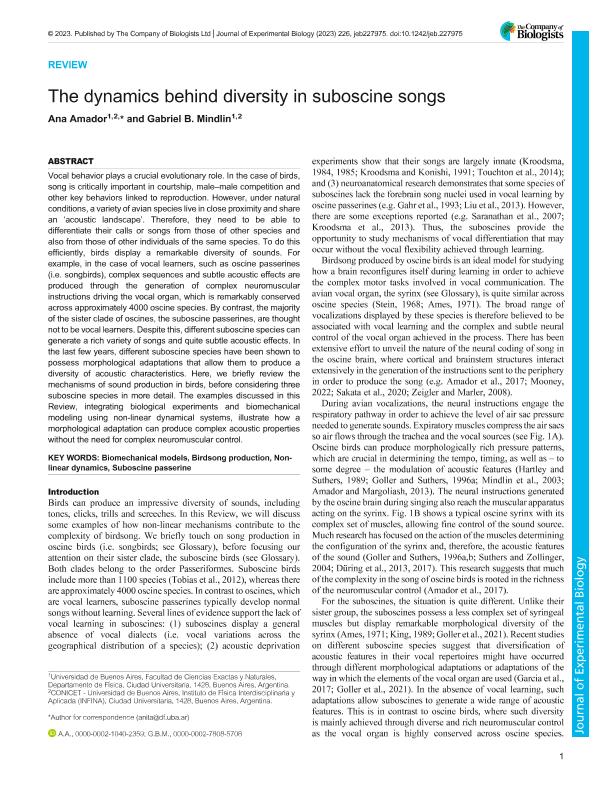Mostrar el registro sencillo del ítem
dc.contributor.author
Amador, Ana

dc.contributor.author
Mindlin, Bernardo Gabriel

dc.date.available
2024-02-26T13:36:08Z
dc.date.issued
2023-06
dc.identifier.citation
Amador, Ana; Mindlin, Bernardo Gabriel; The dynamics behind diversity in suboscine songs; Company of Biologists; Journal of Experimental Biology; 226; 12; 6-2023; 1-10
dc.identifier.issn
0022-0949
dc.identifier.uri
http://hdl.handle.net/11336/228395
dc.description.abstract
Vocal behavior plays a crucial evolutionary role. In the case of birds, song is critically important in courtship, male–male competition and other key behaviors linked to reproduction. However, under natural conditions, a variety of avian species live in close proximity and share an ‘acoustic landscape’. Therefore, they need to be able to differentiate their calls or songs from those of other species and also from those of other individuals of the same species. To do this efficiently, birds display a remarkable diversity of sounds. For example, in the case of vocal learners, such as oscine passerines (i.e. songbirds), complex sequences and subtle acoustic effects are produced through the generation of complex neuromuscular instructions driving the vocal organ, which is remarkably conserved across approximately 4000 oscine species. By contrast, the majority of the sister clade of oscines, the suboscine passerines, are thought not to be vocal learners. Despite this, different suboscine species can generate a rich variety of songs and quite subtle acoustic effects. In the last few years, different suboscine species have been shown to possess morphological adaptations that allow them to produce a diversity of acoustic characteristics. Here, we briefly review the mechanisms of sound production in birds, before considering three suboscine species in more detail. The examples discussed in this Review, integrating biological experiments and biomechanical modeling using non-linear dynamical systems, illustrate how a morphological adaptation can produce complex acoustic properties without the need for complex neuromuscular control.
dc.format
application/pdf
dc.language.iso
eng
dc.publisher
Company of Biologists

dc.rights
info:eu-repo/semantics/openAccess
dc.rights.uri
https://creativecommons.org/licenses/by-nc-sa/2.5/ar/
dc.subject
BIOMECHANICAL MODELS
dc.subject
BIRDSONG PRODUCTION
dc.subject
NONLINEAR DYNAMICS
dc.subject
SUBOSCINE PASSERINE
dc.subject.classification
Biofísica

dc.subject.classification
Ciencias Biológicas

dc.subject.classification
CIENCIAS NATURALES Y EXACTAS

dc.title
The dynamics behind diversity in suboscine songs
dc.type
info:eu-repo/semantics/article
dc.type
info:ar-repo/semantics/artículo
dc.type
info:eu-repo/semantics/publishedVersion
dc.date.updated
2024-02-26T11:05:25Z
dc.journal.volume
226
dc.journal.number
12
dc.journal.pagination
1-10
dc.journal.pais
Reino Unido

dc.description.fil
Fil: Amador, Ana. Consejo Nacional de Investigaciones Científicas y Técnicas. Oficina de Coordinación Administrativa Ciudad Universitaria. Instituto de Física del Plasma. Universidad de Buenos Aires. Facultad de Ciencias Exactas y Naturales. Instituto de Física del Plasma; Argentina
dc.description.fil
Fil: Mindlin, Bernardo Gabriel. Consejo Nacional de Investigaciones Científicas y Técnicas. Oficina de Coordinación Administrativa Ciudad Universitaria. Instituto de Física del Plasma. Universidad de Buenos Aires. Facultad de Ciencias Exactas y Naturales. Instituto de Física del Plasma; Argentina
dc.journal.title
Journal of Experimental Biology

dc.relation.alternativeid
info:eu-repo/semantics/altIdentifier/url/https://journals.biologists.com/jeb/article/226/12/jeb227975/316747/The-dynamics-behind-diversity-in-suboscine-songs
dc.relation.alternativeid
info:eu-repo/semantics/altIdentifier/doi/http://dx.doi.org/10.1242/jeb.227975
Archivos asociados
